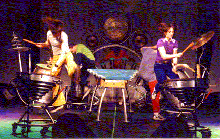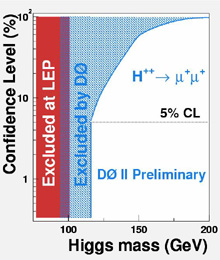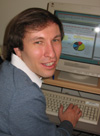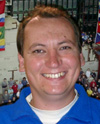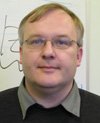 | Thursday, November 13, 2003 |
|
Thursday, November 13 9:00 a.m.- 7:00 p.m. de Sitter Days: alphavac to omegalambda The Fermilab Workshop on Quantum Aspects of de Sitter Space and the Physical Vacuum THERE WILL BE NO THEORETICAL PHYSICS SEMINAR THIS WEEK 3:30 p.m. DIRECTOR'S COFFEE BREAK - 2nd Flr X-Over 4:00 p.m. Accelerator Physics and Technology Seminar - 1 West Speaker: E. McCrory, Fermilab Title: A Monte Carlo Model of Tevatron Collider Operations
Friday, November 14
Saturday, November 15 |
|
Thursday, November 13 Garden vegetable soup Smoked ham w/fresh spinach and mozzarella wrap $4.75 Stuffed potato bar w/chili, cheese and all the toppings $4.25 Rustic chicken salad over wild greens w/fresh fruit $3.75 Roasted turkey piled high w/sauerkraut and Thousand Island dressing on grilled marble rye $4.75 Roasted pork loin carved to order $4.75 Eurest Dining Center Weekly Menu Chez Leon |
|
Extended Forecast |
Secon Level 3 |
| Fermilab Today is online at: http://www.fnal.gov/today/ Submit items to today@fnal.gov Fermilab Today archive Fermilab Today classifieds Subscribe/Unsubscribe to |
| ||
|
Fermilab Arts Series Scrap Arts Music - 11/15 at 8:00 p.m. Few Tickets Still Available! What happens when Stomp meets Blue Man Group meets Jellyeye Drum Theatre? Scrap Arts Music! Scrap Arts Music stimulates your senses. By bringing together five talented musicians, powerful original music, dazzling sculptural instruments and hyper-kinetic movement, the ensemble always leaves audiences wanting more. Based in Vancouver, Canada, this innovative troupe is led by percussionist Gregory Kozak. He is also composer, performer, and inventor of the transforming, futuristic instruments used by Scrap Arts Music. Kozak's awe-inspiring musical creations are handcrafted from the cast-away scraps of industrial production. His compositions are a groove-based fusion of world music traditions and 21st Century sounds. Passions and personalities pulsate wildly during Scrap Arts visually stunning and audibly unforgettable "action-percussion." more information |
| Yesterday, Fermilab Today ran the story, "MIPP Collaborators Celebrate End of Preparation, Start of Data Taking." In the article, we state that Lawrence Livermore National Laboratory donated the detector central to the experiment, a time projection chamber. This statement is incorrect. Lawrence Berkeley National Laboratory donated this item to MIPP, not Lawrence Livermore National Laboratory. Fermilab Today apologizes for any confusion. |
|
November 10 - November 12 - Cable pull between TeV sectors A1 and A2 finished - Future Plans - The Fermi Accelerator Complex View the current accelerator update View the Tevatron Luminosity Charts |
|
From Crain's Chicago Business, November 12, 2003 Argonne, Fermi poised for projects Could snare scientific research critical to U.S. By Paul Merrion WASHINGTON—Two national labs in suburban Chicago are potentially big winners in a 20-year roadmap of the nation's top priorities for new scientific research facilities announced by the Department of Energy on Monday.
Four of the top 28 projects tied for third place in priority, and Argonne National Laboratory is well-positioned for two of them, including the $1-billion rare isotope accelerator and a biological research facility to mass produce and characterize proteins.
|
|
From The New York Times, November 12, 2003 Cheese for Rocket Scientists, and Others By Melissa Clark It's hard to take a cheese seriously when it shares its name with both a subatomic particle and a computer application. Or, perhaps, it's hard to take the subatomic particle or the application seriously since they share their name with a cheese. However you look at it, quark, the cheese, has always deserved both its own identity and more respect.
Quark is a fresh, soft, white cow's-milk cheese with a tart, tangy, milky flavor reminiscent of yogurt or fromage blanc. Its texture, however, is richer and denser, almost like crème fraîche. The cheese is thick enough to be a substitute for cream cheese on a bagel or in a dip, yet light enough to whip and dollop over sugared berries or a slice of fruit pie.
|
|
DZero: Are there exotic Higgs particles? | ||||
| ||||
|
The hunt for the Higgs particle at the Tevatron has just begun. While
searching for the Higgs particle predicted by the Standard Model of
particle physics, physicists at DZero are also exploring various
more exotic Higgs scenarios.
The masses of neutrinos are expected to be small compared to the mass of other elementary particles like the electron. One group of theories which are prime candidates for explaining these small neutrino masses also predict an exotic kind of Higgs particle, the doubly-charged Higgs or H++.
Fermilab is currently the best place in the world to look for the doubly-charged Higgs. Physicists working at Fermilab's DZero experiment have searched for events where these spectacular new particles would decay into two muons of the same charge. Such a process would violate lepton number conservation assumed in the Standard Model. Using the data taken by the DZero experiment since 2002, DZero physicists have found no candidate events compatible with signal and can already show that H++ particles decaying into muons must have a mass greater than 116 GeV. This extends the previous world best limit of about 100 GeV obtained by the Large Electron-Positron Collider (LEP) at CERN. | ||||
| ||||
|
Fermilab Annual Blood Drive Mark your calendars! Fermilab's annual blood drive will be held on December 8th & 9th, 2003 from 8:00 a.m. to 3:00 p.m. in Wilson Hall. Appointments can be scheduled online or by calling Lori at x6615.
Fermilab Film Society |
